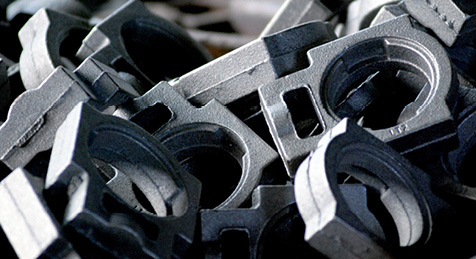Foundries benefit from deburring cells by gKteso
Burrs on castings are processed and removed multi-axially
Foundries pursue one of the oldest forming processes. Hereby, liquid material turns into a solid body after setting. The castings are determined by the form in which the liquid material is poured. Casting parts are cast when they cannot be produced by means of other manufacturing procedures, when it is uneconomic or when special casting material properties are desired. The disadvantage of this process: Burrs that often arise on the workpieces need to be removed after casting. In the course of process optimization, ever more foundries emphasize on automated processes, also in this important production step. To meet these needs, gKteso has developed fully automated, multi-axle deburring cells delivering not only best processing results but also exceptional efficiency, due to their line-capability.

Castings mostly come with burrs
Particularly advantageous for foundries is the mass production of components mostly found in mechanical engineering and in the automotive industry. The challenge here is: In most cases, after manufacturing, castings come with burrs that need to be removed ahead of further processing. The highest maxim in deburring is to keep the post-processing effort as low as possible. The aim is to optimize castings in little time, which is of fundamental significance for the production procedureÔÇÖs efficiency in foundries. Here, deburring cells by gKteso suggest themselves.
Deburring cells by gKteso
Burrs are removed by means of deburring cells by gKteso through grinding and/or milling of the edges. In these systems even simple milling- and drilling tasks on aluminum die cast parts can be accomplished. Aside from classical applications, deburring cells are ideal for 3D-trimming and drillings. The customer may choose between a workpiece-guided or a tool-guided system. In workpiece-guided deburring, the part to be processed for deburring, drillings and brushing, is moved along diverse spindles. In this process, cycle times are shorter than in tool-guided deburring. In the latter case, the workpiece is clamped into a device and successively processed with the tools. Depending on the type, the clamping devices are located either on the worktop or at the motor system. Regardless to the chosen process, both procedures achieve the same surface quality that may be an essential factor for foundries.
Foundries benefit from trouble-free post-processing
Especially foundries, but also enterprises in the aerospace industry as well as the automotive and supplier industry benefit from trouble-free post-processing of components with deburring cells by gKteso. The systems can be optionally equipped with an additional rotary axis. The completely closed workspace meets the high safety requirements. You have questions about deburring of casting parts with deburring cells by gKteso and about our special offer for foundries? Then give us a call or write us.



 Download Datasheets
Download Datasheets